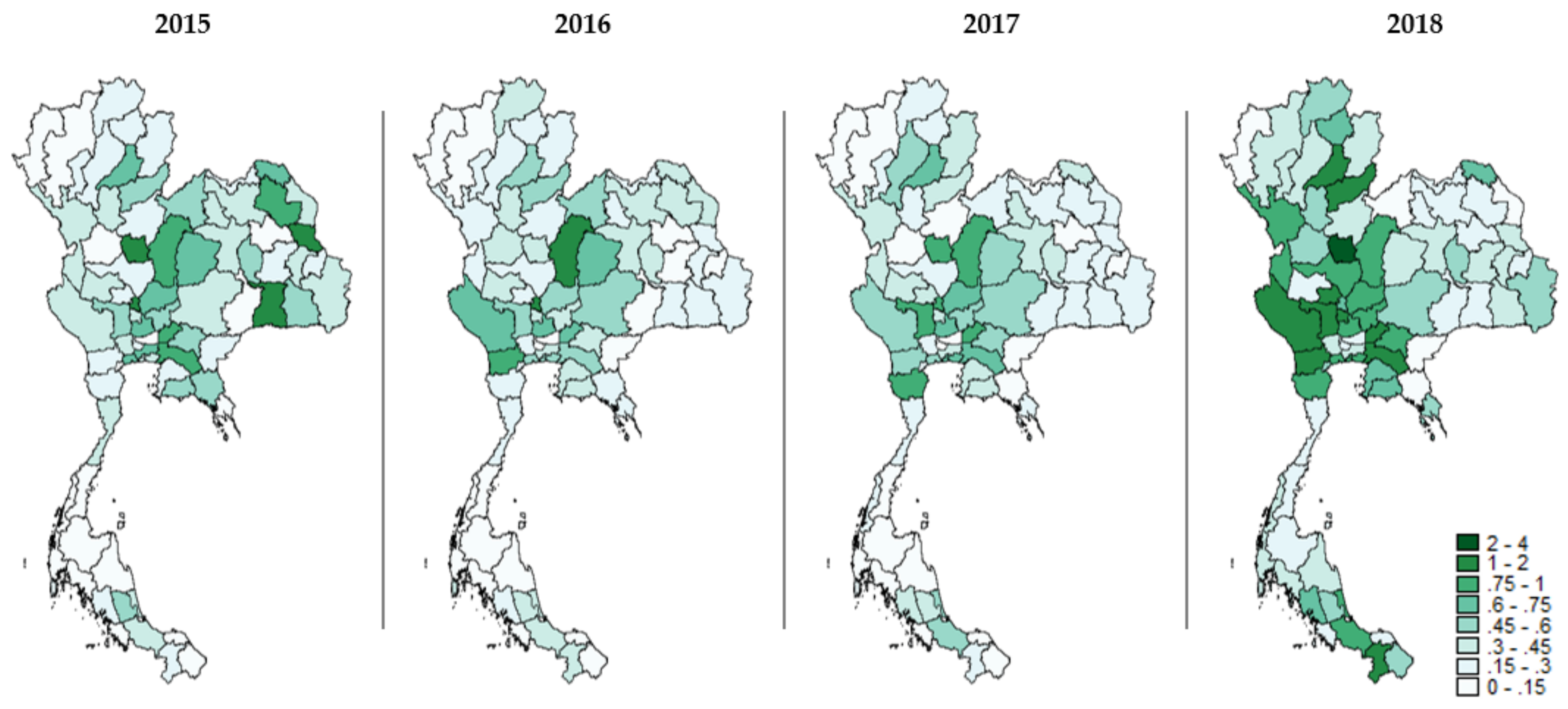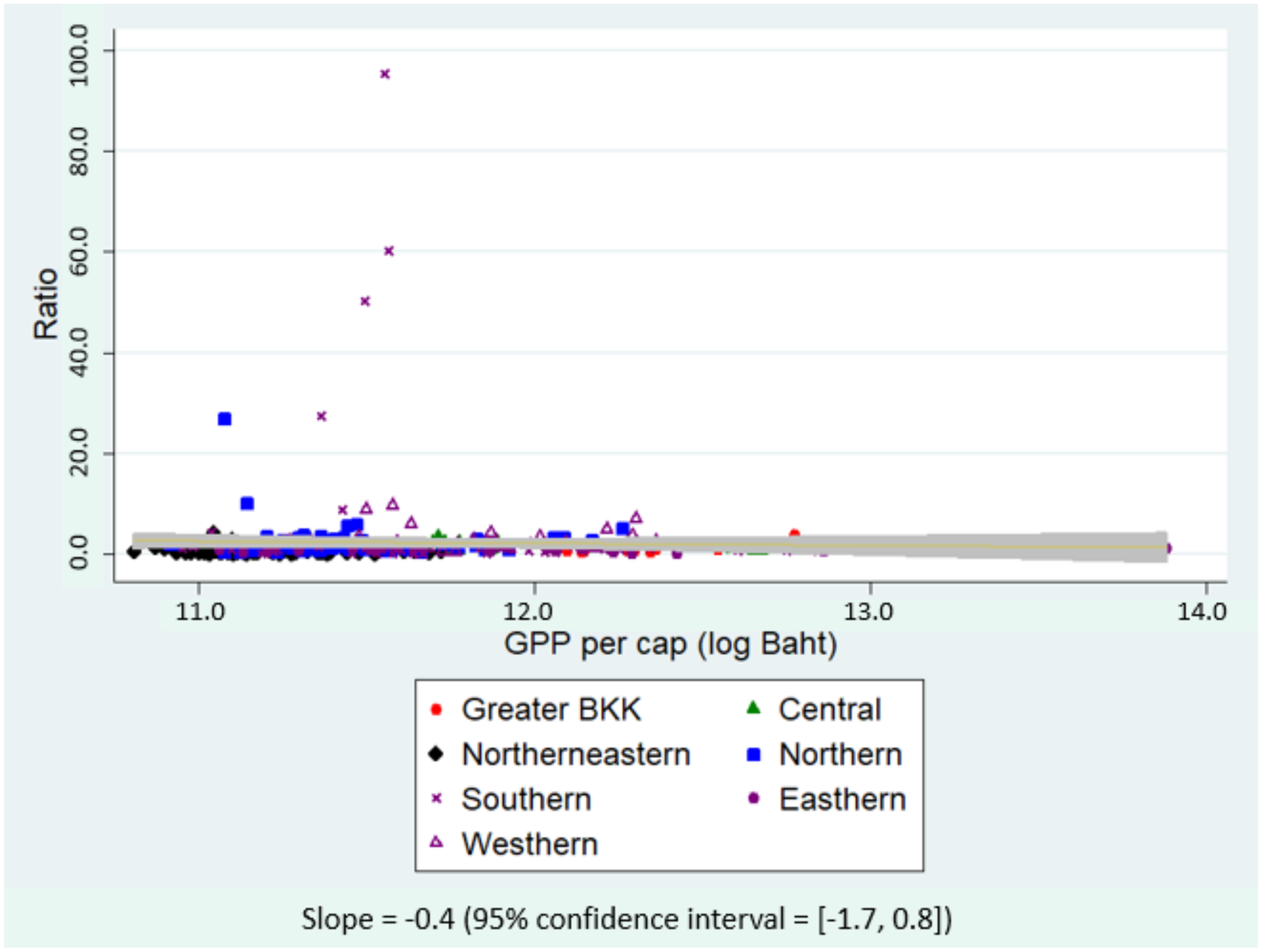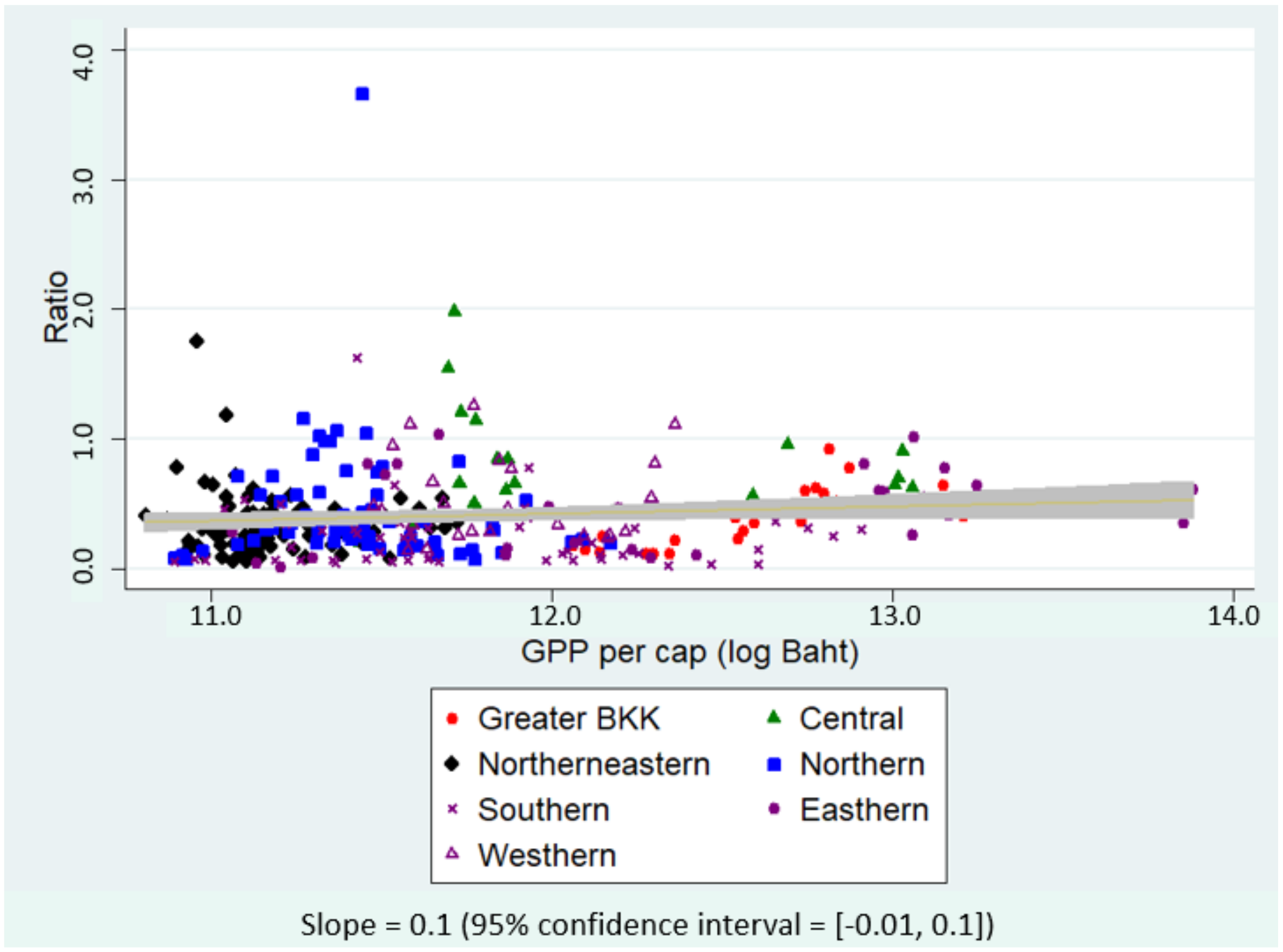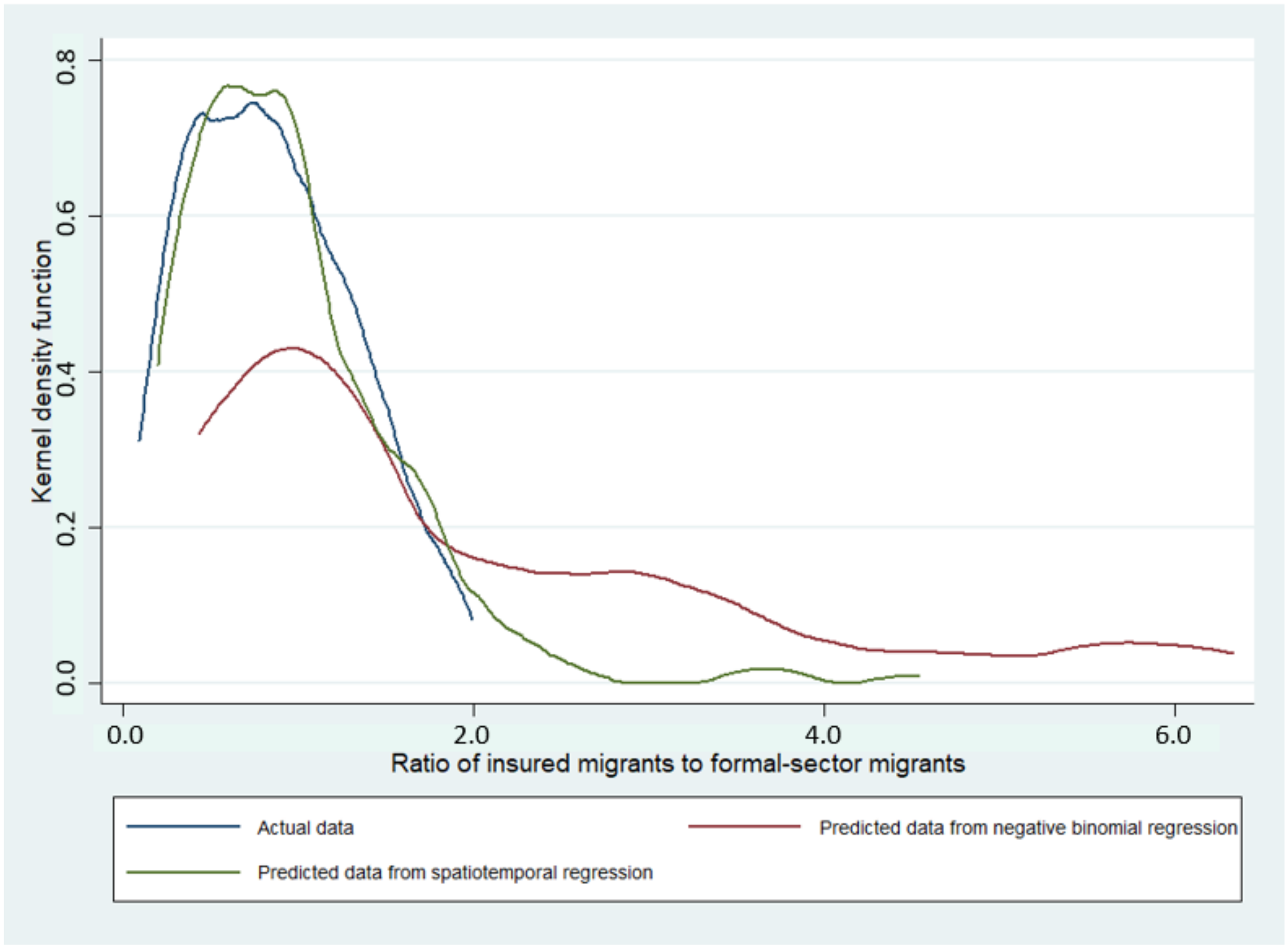Spatial Panel Data Analysis on the Relationship between Provincial Economic Status and Enrolment in the Social Security Scheme amongst Migrant Workers in Thailand, 2015–2018
Abstract
:1. Introduction
2. Materials and Methods
2.1. Study Design
2.2. Data Sources and Variables
2.3. Data Analysis
2.4. Model Fitness Assessment
3. Results
3.1. Descriptive Analysis
3.2. Negative Binomial (NB) Regression
3.3. Spatiotemporal Regression
3.4. Goodness-of-Fit Check
4. Discussion
5. Conclusions
Author Contributions
Funding
Institutional Review Board Statement
Informed Consent Statement
Data Availability Statement
Acknowledgments
Conflicts of Interest
References
- Aldridge, R.W.; Nellums, L.; Bartlett, S.; Barr, A.L.; Patel, P.; Burns, R.; Hargreaves, S.; Miranda, J.J.; Tollman, S.; Friedland, J.S.; et al. Global patterns of mortality in international migrants: A systematic review and meta-analysis. Lancet 2018, 392, 2553–2566. [Google Scholar] [CrossRef] [Green Version]
- Koser, K.; Laczko, F. World Migration Report 2010: The Future of Migration: Building Capacities for Change; International Organization for Migration: Geneva, Switzerland, 2010; p. 115. [Google Scholar]
- International Organization for Migration (IOM). World Migration Report 2020; IMO: Geneva, Switzerland, 2020. [Google Scholar]
- Macpherson, D.W.; Gushulak, B.D.; Macdonald, L. Health and foreign policy: Influences of migration and population mobility. Bull. World Health Organ. 2007, 85, 200–206. [Google Scholar] [CrossRef] [PubMed]
- Guinto, R.L.L.R.; Curran, U.Z.; Suphanchaimat, R.; Pocock, N.S. Universal health coverage in ‘One ASEAN’: Are migrants included? Glob. Health Action 2015, 8, 25749. [Google Scholar] [CrossRef] [PubMed]
- International Organization for Migration. Thailand Migration Report 2019; IMO: Geneva, Switzerland, 2019. [Google Scholar]
- United Nations Thematic Working Group on Migration in Thailand. Thailand Migrant Report 2019; IOM UN: Bangkok, Thailand, 2019. [Google Scholar]
- Foreign Workers Administration Office. Number of Registered Migrant Workers in Thailand, October 2021; Foreign Workers Administration Office: Bangkok, Thailand, 2021. (In Thai) [Google Scholar]
- Official Statistics Registration Systems. Population by Age Groups. 2021. Available online: https://stat.bora.dopa.go.th/stat/statnew/statMONTH/statmonth/#/displayData (accessed on 27 November 2021).
- OECD/ILO. How Immigrants Contribute to Thailand’s Economy, OECD Development Pathways; OECD Publishing: Paris, France, 2017. [Google Scholar]
- Suphanchaimat, R.; Putthasri, W.; Prakongsai, P.; Tangcharoensathien, V. Evolution and complexity of government policies to protect the health of undocumented/illegal migrants in Thailand—The unsolved challenges. Risk Manag. Healthc. Policy 2017, 10, 49–62. [Google Scholar] [CrossRef] [PubMed] [Green Version]
- Tangcharoensathien, V.; Thwin, A.A.; Patcharanarumol, W. Implementing health insurance for migrants, Thailand. Bull. World Health Organ. 2017, 95, 146–151. [Google Scholar] [CrossRef] [PubMed]
- Ministry Of Labour. Labour Statistics Yearbook 2019; The Office Of Permanent Secretary: Bangkok, Thailand, 2019. [Google Scholar]
- Paitoonpong, S.; Chalamwong, Y. Managing International Labor Migration in ASEAN: A Case of Thailand; Thailand Development Research Institute (TDRI): Bangkok, Thailand, 2012. [Google Scholar]
- Elhorst, J.P. Spatial Panel Data Models. In Spatial Econometrics: From Cross-Sectional Data to Spatial Panels; Elhorst, J.P., Ed.; Springer: Berlin/Heidelberg, Germany, 2014; pp. 37–93. [Google Scholar]
- Suphanchaimat, R.; Sornsrivichai, V.; Limwattananon, S.; Thammawijaya, P. Economic development and road traffic injuries and fatalities in Thailand: An application of spatial panel data analysis, 2012–2016. BMC Public Health 2019, 19, 1449. [Google Scholar] [CrossRef] [PubMed]
- Social Security Act (No.4), B.E. 2558 (2015). 2010. Available online: http://www3.mol.go.th/content/63658/1506917594 (accessed on 22 November 2021).
- Kunpeuk, W.; Teekasap, P.; Kosiyaporn, H.; Julchoo, S.; Phaiyarom, M.; Sinam, P.; Pudpong, N.; Suphanchaimat, R. Understanding the Problem of Access to Public Health Insurance Schemes among Cross-Border Migrants in Thailand through Systems Thinking. Int. J. Environ. Res. Public Health 2020, 17, 5113. [Google Scholar] [CrossRef] [PubMed]
- Hesketh, T.; Ye, X.J.; Li, L.; Wang, H.M. Health status and access to health care of migrant workers in China. Public Health Rep. 2008, 123, 189–197. [Google Scholar] [CrossRef] [PubMed] [Green Version]
- United Nations Thematic Working Group on Migration in Thailand. Thailand Migrant Report 2014; IOM UN: Bangkok, Thailand, 2014. [Google Scholar]
- National Statistical Office. Demography Population and Housing Branch: Number of Population from Registration by Sex, Area, Density, House, Region and Province: 2010–2019; National Statistical Office: Bangkok, Thailand, 2021. [Google Scholar]
- Suphanchaimat, R.; Kunpeuk, W.; Phaiyarom, M.; Nipaporn, S. The Effects of the Health Insurance Card Scheme on Out-of-Pocket Expenditure Among Migrants in Ranong Province, Thailand. Risk Manag. Healthc. Policy 2019, 12, 317–330. [Google Scholar] [CrossRef] [PubMed] [Green Version]
- Phaiyarom, M.; Pudpong, N.; Suphanchaimat, R.; Kunpeuk, W.; Julchoo, S.; Sinam, P. Outcomes of the Health Insurance Card Scheme on Migrants’ Use of Health Services in Ranong Province, Thailand. Int. J. Environ. Res. Public Health 2020, 17, 4431. [Google Scholar] [CrossRef] [PubMed]
- Suphanchaimat, R.; Sinam, P.; Phaiyarom, M.; Pudpong, N.; Julchoo, S.; Kunpeuk, W.; Thammawijaya, P. A cross sectional study of unmet need for health services amongst urban refugees and asylum seekers in Thailand in comparison with Thai population. 2019. Int. J. Equity Health 2020, 19, 205. [Google Scholar] [CrossRef] [PubMed]






| Year | 2015 | 2016 | 2017 | 2018 | Average Annual Growth Rate |
|---|---|---|---|---|---|
| Total migrants | |||||
| Greater BKK | 656,725 | 763,88 | 855,750 | 1,248,091 | 30% |
| Central | 36,612 | 39,868 | 40,218 | 49,637 | 12% |
| Northeastern | 23,029 | 22,332 | 26,851 | 50,538 | 40% |
| Northern | 174,100 | 174,065 | 152,936 | 171,226 | −1% |
| Southern | 312,787 | 293,428 | 292,044 | 361,694 | 5% |
| Eastern | 211,343 | 154,124 | 164,835 | 260,373 | 8% |
| Western | 91,938 | 75,195 | 74,298 | 128,528 | 13% |
| Formal-sector migrants | |||||
| Greater BKK | 209,940 | 273,150 | 345,485 | 510,671 | 48% |
| Central | 19,938 | 23,346 | 26,971 | 39,866 | 33% |
| Northeastern | 12,837 | 12,803 | 18,472 | 33,421 | 53% |
| Northern | 32,987 | 18,477 | 24,021 | 29,757 | −3% |
| Southern | 56,547 | 59,984 | 65,680 | 74,719 | 11% |
| Eastern | 76,486 | 75,293 | 96,612 | 153,571 | 34% |
| Western | 13,377 | 19,240 | 21,795 | 44,129 | 77% |
| Formal-sector migrants with the SSS | |||||
| Greater BKK | 279,357 | 277,770 | 291,076 | 622,012 | 41% |
| Central | 22,524 | 21,044 | 23,398 | 49,283 | 40% |
| Northeastern | 9483 | 8458 | 9503 | 20,619 | 39% |
| Northern | 34,122 | 32,747 | 33,508 | 73,478 | 38% |
| Southern | 45,356 | 45,759 | 50,113 | 127,896 | 61% |
| Eastern | 73,311 | 66,800 | 67,33 | 159,965 | 39% |
| Western | 27,963 | 35,428 | 34,804 | 85,256 | 68% |
| Year | 2015 | 2016 | 2017 | 2018 |
|---|---|---|---|---|
| Insured migrants to formal-sector migrants | ||||
| Mean (sd) | 3.6 (9.9) | 2.5 (7.2) | 2.0 (7.3) | 2.9 (11.4) |
| Median (iqr) | 1.2 (2.2) | 0.9 (1.4) | 0.8 (0.9) | 1.1 (1.1) |
| Min/Max | 0.0/114.6 | 0.0/78.7 | 0.0/80.8 | 0.1/133.6 |
| Insured migrants to all migrants | ||||
| Mean (sd) | 0.8 (2.7) | 0.5 (1.2) | 0.5 (1.0) | 0.6 (0.5) |
| Median (iqr) | 0.3 (0.4) | 0.3 (0.3) | 0.3 (0.4) | 0.4 (0.5) |
| Min/Max | 0.0/51.8 | 0.0/24.2 | 0.0/16.1 | 0.0/4.5 |
| GPP per capita (THB) | ||||
| Mean (sd) | 146,575.7 (141,654.5) | 154,341.0 (146,360.6) | 163,044.7 (155,287.0) | 169,506.6 (162,109.2) |
| Median (iqr) | 94,772.0 (93,987.0) | 98,141.0 (102,399.0) | 105,345.0 (112,669.0) | 107,505.0 (104,095.0) |
| Min/Max | 49,288.0/959,678.0 | 54,957.0/972,955.0 | 55,661.0/1,038,355.0 | 58,370.0/1,067,449.0 |
| Agriculture, forestry and fishing (% GPP per capita) | ||||
| Mean (sd) | 15.6 (10.6) | 14.9 (10.0) | 14.7 (9.8) | 14.8 (9.8) |
| Median (iqr) | 13.3 (14.7) | 12.9 (15.0) | 12.7 (15.0) | 12.9 (14.3) |
| Min/Max | 0.5/42.4 | 0.5/38.2 | 0.4/40.6 | 0.4/39.5 |
| Manufacturing (% GPP per capita) | ||||
| Mean (sd) | 18.8 (24.4) | 19.1 (24.1) | 19.4 (24.3) | 19.1 (24.5) |
| Median (iqr) | 8.4 (15.2) | 9.2 (13.9) | 8.9 (14.3) | 8.5 (15.4) |
| Min/Max | 0.9/112.0 | 0.8/110.6 | 0.7/104.1 | 0.6/103.0 |
| Construction (% GPP per capita) | ||||
| Mean (sd) | 3.2 (2.9) | 3.2 (2.9) | 3.1 (2.9) | 3.1 (2.8) |
| Median (iqr) | 2.4 (2.4) | 2.4 (2.4) | 2.2 (2.2) | 2.2 (2.1) |
| Min/Max | 0.4/19.6 | 0.4/18.8 | 0.3/19.2 | 0.4/18.5 |
| Wholesale and retail trade and repair of motor vehicles (% GPP per capita) | ||||
| Mean (sd) | 11.5 (20.5) | 12.1 (21.6) | 12.6 (22.1) | 13.0 (23.0) |
| Median (iqr) | 7.3 (7.1) | 7.7 (8.2) | 8.1 (8.2) | 8.5 (8.7) |
| Min/Max | 1.7/179.9 | 1.8/189.4 | 2.0/193.3 | 1.8/200.7 |
| Accommodation and food service activities (% GPP per capita) | ||||
| Mean (sd) | 2.7 (8.3) | 2.8 (8.8) | 3.1 (9.8) | 3.4 (10.4) |
| Median (iqr) | 0.4 (1.2) | 0.4 (1.4) | 0.5 (1.4) | 0.5 (1.6) |
| Min/Max | 0.0/65.6 | 0.0/69.2 | 0.0/78.4 | 0.0/83.0 |
| Dependent Variables | Ratio of Insured Migrants to Formal-Sector Migrants | Ratio of Insured Migrants to All Migrants | ||||
|---|---|---|---|---|---|---|
| IRR | 95% CI | p-Value | IRR | 95% CI | p-Value | |
| GPP per capita—log Baht | 0.817 | 0.569–1.171 | 0.271 | 0.915 | 0.685–1.223 | 0.550 |
| Region (reference = Greater Bangkok and its vicinity) | ||||||
| Central | 1.154 | 0.617–2.157 | 0.653 | 2.667 | 1.644–4.328 | <0.001 |
| Northeastern | 0.583 | 0.304–1.118 | 0.104 | 1.391 | 0.830–2.332 | 0.210 |
| Northern | 2.226 | 1.162–4.265 | 0.016 | 1.872 | 1.118–3.135 | 0.017 |
| Southern | 4.888 | 2.540–9.405 | <0.001 | 1.119 | 0.658–1.901 | 0.679 |
| Eastern | 0.874 | 0.490–1.560 | 0.649 | 1.651 | 1.046–2.606 | 0.031 |
| Western | 3.036 | 1.561–5.906 | 0.001 | 2.189 | 1.291–3.713 | 0.004 |
| Agriculture, forestry, and fishing—% GPP per capita | 0.983 | 0.967–0.999 | 0.042 | 0.998 | 0.985–1.011 | 0.773 |
| Manufacturing—% GPP per capita | 0.999 | 0.989–1.009 | 0.823 | 1.007 | 0.999–1.015 | 0.088 |
| Construction—% GPP per capita | 0.963 | 0.884–1.049 | 0.385 | 0.953 | 0.891–1.020 | 0.165 |
| Wholesale and retail trade and repair of motor vehicles—% GPP per capita | 1.025 | 1.010–1.041 | 0.001 | 1.011 | 0.999–1.023 | 0.081 |
| Accommodation and food service activities—% GPP per capita | 0.946 | 0.917–0.976 | <0.001 | 0.985 | 0.963–1.008 | 0.209 |
| Dependent Variables | Insured Migrants in Formal Sector | Insured Migrants in All Sectors | ||||
|---|---|---|---|---|---|---|
| IRR | IRR 95% CI | p-Value | IRR | IRR 95% CI | p-Value | |
| GPP per capita—log Baht | 0.637 | 0.301–1.352 | 0.240 | 1.682 | 1.065–2.656 | 0.026 |
| Region (reference = Greater Bangkok and its vicinity) | ||||||
| Central | 1.703 | 0.533–5.436 | 0.369 | 3.931 | 1.616–9.566 | 0.003 |
| Northeastern | 1.742 | 0.524–5.788 | 0.365 | 7.015 | 1.823–26.985 | 0.005 |
| Northern | 2.160 | 0.637–7.327 | 0.217 | 4.601 | 1.448–14.624 | 0.010 |
| Southern | 0.222 | 0.015–3.383 | 0.279 | 6.100 | 1.448–25.691 | 0.014 |
| Eastern | 2.143 | 0.550–8.353 | 0.272 | 11.313 | 2.692–47.538 | 0.001 |
| Western | 2.937 | 1.041–8.284 | 0.042 | 5.598 | 2.448–12.799 | <0.001 |
| Agriculture, forestry, and fishing—% GPP per capita | 0.999 | 0.975–1.022 | 0.906 | 0.995 | 0.977–1.012 | 0.543 |
| Manufacturing—% GPP per capita | 1.009 | 0.995–1.022 | 0.216 | 1.002 | 0.993–1.010 | 0.713 |
| Construction—% GPP per capita | 0.957 | 0.866–1.057 | 0.388 | 0.991 | 0.896–1.097 | 0.867 |
| Wholesale and retail trade and repair of motor vehicles—% GPP per capita | 0.997 | 0.975–1.018 | 0.754 | 1.015 | 0.997–1.033 | 0.107 |
| Accommodation and food service activities—% GPP per capita | 1.007 | 0.959–1.057 | 0.788 | 0.981 | 0.946–1.018 | 0.316 |
| Assessment | Insured Migrants to Formal-Sector Migrants | Insured Migrants in All Migrants | ||
|---|---|---|---|---|
| NB Regression | Spatiotemporal Regression | NB Regression | Spatiotemporal Regression | |
| MAE | 2.0 | 0.8 | 0.2 | 0.1 |
| MSE | 48.3 | 14.4 | 0.1 | 0.1 |
| RMSE | 7.0 | 3.8 | 0.3 | 0.3 |
| MAPE | 189.9 | 34.8 | 97.7 | 36.9 |
| AIC | 5336.8 | 628.0 | 5146.8 | 609.5 |
Publisher’s Note: MDPI stays neutral with regard to jurisdictional claims in published maps and institutional affiliations. |
© 2021 by the authors. Licensee MDPI, Basel, Switzerland. This article is an open access article distributed under the terms and conditions of the Creative Commons Attribution (CC BY) license (https://creativecommons.org/licenses/by/4.0/).
Share and Cite
Viriyathorn, S.; Phaiyarom, M.; Rueangsom, P.; Suphanchaimat, R. Spatial Panel Data Analysis on the Relationship between Provincial Economic Status and Enrolment in the Social Security Scheme amongst Migrant Workers in Thailand, 2015–2018. Int. J. Environ. Res. Public Health 2022, 19, 181. https://doi.org/10.3390/ijerph19010181
Viriyathorn S, Phaiyarom M, Rueangsom P, Suphanchaimat R. Spatial Panel Data Analysis on the Relationship between Provincial Economic Status and Enrolment in the Social Security Scheme amongst Migrant Workers in Thailand, 2015–2018. International Journal of Environmental Research and Public Health. 2022; 19(1):181. https://doi.org/10.3390/ijerph19010181
Chicago/Turabian StyleViriyathorn, Shaheda, Mathudara Phaiyarom, Putthipanya Rueangsom, and Rapeepong Suphanchaimat. 2022. "Spatial Panel Data Analysis on the Relationship between Provincial Economic Status and Enrolment in the Social Security Scheme amongst Migrant Workers in Thailand, 2015–2018" International Journal of Environmental Research and Public Health 19, no. 1: 181. https://doi.org/10.3390/ijerph19010181







